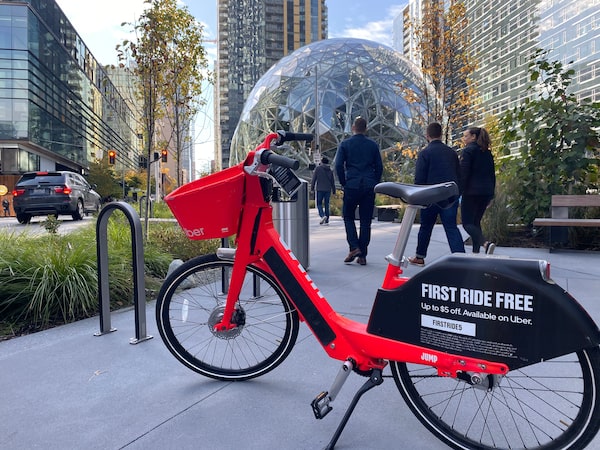
Dockless Jump bike in SeattleJason Tchir/The Globe and Mail
In downtown Seattle, if you’re trying to find the nearest shared e-bike, you could check an app. But, typically, all you really need to do is look down the sidewalk six feet in front of you.
They’re on every street, standing next to light posts, up against railings on bridges and occasionally in the middle of the sidewalk.
In 2017, Seattle was the first U.S. city to allow dockless bike-sharing. Instead of leaving bikes in a docking station, like you do in cities including New York, Montreal, Toronto and Vancouver, you leave them, well, almost anywhere.
While dockless e-scooters in Kelowna, Calgary, Edmonton and Montreal are getting more attention, Calgary started a dockless e-bike-sharing pilot last fall. Montreal got dockless e-bikes this summer.
Seattle’s bikes, operated by Lime and Uber-owned Jump, appeared four months after Seattle shut down Pronto, its three-year-old docked bike-share system, because not enough people were using it.
Why did people prefer to go dockless in Seattle? And might dockless systems replace the stations we see in Canadian cities now?
“For Pronto, there weren’t enough stations and they weren’t close to where people were or where they wanted to go,” says Don MacKenzie, a University of Washington associate professor who studied the docked system’s failure. “When the dockless services came in later, they were deployed at a greater scale, so in many places of the city there’s always a bike nearby and you can take it wherever you want to go.”
There have to be bikes where people need them. If that dock is a 15-minute walk from where you are, and the drop-off dock is 20 minutes from where you’re going, you probably won’t take a shared bike.
Public or private?
The downsides of docks? The docks cost money, especially if they include charging for e-bikes.
With dockless bikes, you can just put bikes wherever you think people will use them. If you’re wrong and they don’t get used there, you can just put them on a truck and easily move them.
That means dockless systems might work well for a city that’s just starting a bike-sharing system and isn’t sure whether people will use it, MacKenzie says.
Unlike docked systems, which are typically partly or entirely run by a city, dockless systems are often entirely run by private companies.
They haven’t always fared well. Most companies that once offered dockless pedal-powered bikes have either shut down or switched to e-bikes and, increasingly, e-scooters.
Montreal already had a popular docked bike share system – Bixi, which offers pedal bikes and e-bikes – before it added Jump dockless e-bikes. Calgary chose Lime, which offers dockless e-bikes, because it didn’t want to sink public funds into bike-sharing.
“A lot of places that have done docked bike-sharing have had to be subsidized,” says Andrew Sedor, business development co-ordinator, transportation strategy, with the city of Calgary.
But dockless systems tend to be more expensive for riders. In Montreal, a 30-minute Bixi trip is $2.95, plus a dollar more if you choose an e-bike.
Jump only offers dockless e-bikes and charges users 30 cents a minute. So a 30-minute ride costs $9, three times more than Bixi.
While cities have tried to require dockless bikes to be left in specific parking zones, on bike racks or off to the side on sidewalks, they can still end up blocking sidewalks.
In Montreal, for instance, they’re supposed to be locked to bicycle racks at the end of the ride. If you don’t lock it up, it’s a $50 fine for users and a $100 fine to Uber. But the bikes still get left where they shouldn’t be.
“In a mature bike-share system, a docked system might work better because it’s more orderly and it reduces the clutter,” MacKenzie says. “Once there are enough stations, it works well.”
And while companies keep their books private, it costs them money to send contractors to maintain and recharge the bikes. If companies end up losing money, they’ll pull their bikes.
That means for dockless bike systems to really take off, they might need to be run in partnerships with cities, says a McGill researcher who studied dockless bike-sharing in Washington D.C.
“I think going dockless will be the direction in the future,” says Grant McKenzie, assistant professor in the department of geography at McGill University. “But I think we’ll be seeing more public-private partnerships – cities need to be able to support maintenance and policing, which is what these commercial companies haven’t been able to do.”
Have a driving question? Send it to globedrive@globeandmail.com. Canada’s a big place, so let us know where you are so we can find the answer for your city and province.
Shopping for a new car? Check out the new Globe Drive Build and Price Tool to see the latest discounts, rebates and rates on new cars, trucks and SUVs. Click here to get your price.
Stay on top of all our Drive stories. We have a Drive newsletter covering car reviews, innovative new cars and the ups and downs of everyday driving. Sign up today.